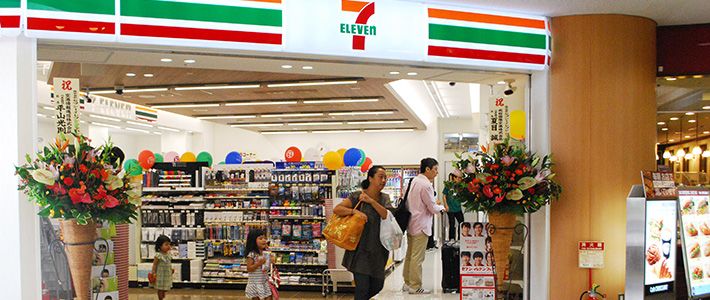
Convenience Stores Cut Themselves More of the Pie
Economy Lifestyle- English
- 日本語
- 简体字
- 繁體字
- Français
- Español
- العربية
- Русский
Konbini Operators Seek Combos
Last week, the world’s first combined convenience store and karaoke venue opened in Tokyo. It’s tempting to imagine customers grabbing a turn at the mic as they pop in for a carton of milk, but that isn’t really the business plan. The karaoke parlor is at the core of this collaboration between FamilyMart and the Karaoke Dam chain. By remodeling to include space for the convenience store, the parlor is bringing FamilyMart onboard to provide catering to singers.
It’s already common practice for patrons to bring their own drinks and snacks, often from convenience stores, into self-service karaoke parlors. The hybrid aims to cut out the walk between them and to save money on staff. As karaoke is an anytime proposition in Japan, daytime crooners may also pick up some groceries on the way home. The two chains plan to open 30 shared venues in the next three years.
The convenience store (or konbini in the local abbreviation) has been a spectacularly successful business model in Japan since around 800 shoppers piled into Tokyo’s first 7-Eleven when it opened on May 15, 1974. The major chains, 7-Eleven, Lawson, and FamilyMart, have grown explosively in the decades since, particularly in the larger cities. However, they have spread so far and wide that there aren’t many good locations left to open stores in the traditional format.
Hence the recent trend of linking up with others to squeeze into gaps in the market. In March this year, 7-Eleven parent company Seven & I Holdings announced plans to convert 500 kiosks and other sales outlets in JR West stations into 7-Eleven stores. (These renewed in-station konbini will include, amazingly enough, the first 7-Eleven ever in Tottori Prefecture.) FamilyMart already has 300 stores in railway stations in Kyūshū and elsewhere. In 2013, the first 7-Eleven store opened in Narita Airport. Other nontraditional locations for openings include hospitals and universities. And konbini chains are also working together with pharmacies to benefit from staff qualified to sell different classes of drugs.
Postdisaster Expansion
At the same time, convenience stores have been working on broadening their appeal. The Great East Japan Earthquake of 2011 was a huge blow to many companies, which struggled to regroup afterward, but all of the big three konbini chains announced record profits for the six months after the disaster. Their rapid recovery of normal service gained the trust of a fresh segment of society that did not previously make heavy use of their stores.
Typical konbini customers had been thought of as men in their twenties and thirties, looking mainly for instant noodles and other simple snacks. However, female and older shoppers who ventured in after March 2011 discovered that there was more to buy than just junk food. In a saturated market, new access to this sizable consumer base has helped convenience store chains to gain a larger slice of the retail pie.
To capitalize on this, the chains have started offering more fresh and healthy food, adapting their lineups to hang on to their new clientele. One of the key targets is otona customers, sophisticated consumers who are willing to pay more for higher quality. Although otona simply means “adult” in English, marketing usage implies maturity and discernment. It has become a huge buzzword. With a quarter of the Japanese population now aged 65 or over, older consumers cannot be ignored.
 Fresh food at Lawson Mart, one of the Lawson chain’s supermarket-style outlets. Ordinary stores also carry an increasing amount of produce and other healthy food. (Photograph courtesy of Jiji Press Photo.)
Fresh food at Lawson Mart, one of the Lawson chain’s supermarket-style outlets. Ordinary stores also carry an increasing amount of produce and other healthy food. (Photograph courtesy of Jiji Press Photo.)
Both 7-Eleven and FamilyMart have introduced two-tier own-brand systems, with more expensive products using better ingredients. Items aimed at older shoppers often are less sweet or feature more traditional Japanese tastes. FamilyMart in particular is working on the otona market with a research unit dedicated to development of products for the over-50 cohort. It even has one Tokyo store specifically designed to attract mature consumers through imported goods, a broad selection of wine, and a shop interior with tasteful wooden furnishings instead of gleaming plastic-and-metal shelves.
Konbini chains have also been trumpeting their role in the social infrastructure. As anybody who lives here soon discovers, the range of services offered by convenience stores in Japan is far wider than those of comparable stores in the United States or Europe. You can routinely use ATMs, pay bills and taxes, buy travel and entertainment tickets, and pick up parcels from online retailers. The reliability of these kinds of services following the 2011 disaster contributed to consumer trust.
Convenience store expansion has eaten away at the share of department stores in the largely stagnant retail sector. In 2008, convenience store sales overtook department store sales for the first time. How much further this trend can go remains to be seen, but the big three chains will no doubt continue to exploit every opening as they strive to get the edge in the konbini battle.
(Banner photo: The first 24-hour convenience store inside Narita International Airport opened in July 2013 as one example of how chains are seeking new locations through partnerships with other companies. Courtesy Jiji Press.)